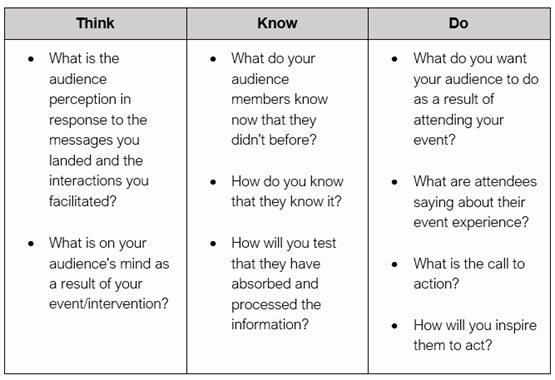The COVID-19 pandemic and the restrictions and new practices of the resulting lockdown have left an indelible mark on the face of many industries, and events are no exception, whether the event takes place online, in the real world, or as a hybrid of both.
As the demand for virtual/hybrid events continues to grow, we need to factor in how we define our approach by focusing on who our audience really is, and then use those insights to design the outcomes and content for our event. Recalibrating how you assess event objectives makes all the difference when creating attendee experiences that drive engagement, impact, legacy, and behavior change.
What That Means
Since the COVID lockdown began, we've gone back and forth between entirely virtual connections—unable to have physical contact with anyone outside our homes—to gradual easing of restrictions with distancing measures still in place. However, with some sectors still due to reopen for business (and the undeniable toll of the pandemic on the travel and hospitality industries), creating bespoke events must pivot away from a "one size fits all" approach.
By thinking laterally about the implications of the latest government guidance—as well as the societal implications of business sectors that are reopening versus those that aren't—we can turn event planning on its head to find ways to innovate in both physical and virtual event spaces.
Looking Ahead
The current period of quiet reflection will be followed by a flurry of activity and concern about how to deliver in a post-pandemic climate that is still not fully back to normal. Senior stakeholders in organizations will be turning to event organizers and asking, "So what should we do, and how can we do it?"
Considering people first will stand you in good stead. Look at the "personas" of your event attendees: the various types of people who use (or might use) your company's services, products, and website. Identifying personas up front will help you understand your delegates' experiences, behaviors, goals, and needs. Doing so in combination with audience segmentation is a powerful lens to apply to event design (see checklist elsewhere in this article).
When seeking to innovate with our new reality as the context, brainstorm ways to create new ways of engagement—for example, highlighting digital content by rolling it out over the course of a few days, pre-recording set pieces, or livestreaming keynotes and panel discussions. Create an immersive experience for attendees by designing events with the goal of gathering people together, even from disparate locations across the globe.
Event Checklist
1. Identify personas
The best way to pinpoint compelling personas is to think of real people. Consider:
- Who they are, where they come from, and what jobs they have
- What has changed since lockdown, and how it has affected their perceptions—of the world in general and of your business
- What communication preferences, if any, have emerged from the lockdown that might impact the way you engage them before, during, and after the event
- What their goals are
- What your goals are in terms of their attending your event
- What challenges you see—barriers that might get in the way of these goals being achieved
2. Apply audience segmentation
Typical marketing segmentation techniques can be overlayed onto your persona mapping. Segmentation typically spans four main categories:
- Demographic: age, race, gender, ethnicity, marital status, income, education, and employment type, for example
- Psychographic: values, desires, goals, interests, and lifestyle choices
- Behavioral: their last event experience and what feedback they gave, for example
- Geographic: the span of regions and culture across your attendees, the range of cultural /societal climates you will be addressing, and the approximate percentage split across your total event population
3. Define your event outcomes and drive behavior change
Having carefully constructed a detailed picture of who your audience is, define your objectives and messaging by using the wider context of your answers to the questions in stages 1 and 2. Distill them into groups according to what you want the main takeaways to be.
Imagine your event is over, and consider the following:

By using these elements as an additional filter, you can construct and demonstrate a logical approach to building the foundations of your event plan.
Source : MarketingProfs </>
Posting Komentar
Posting Komentar